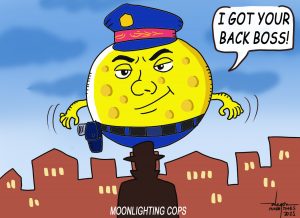The other day we received an e-mail from the Office of the General Manager of the Davao City Water District (DCWD). It was in answer to our earlier request for enlightenment on why when strong rains happen or is forecast to happen, our supply almost always is lost.
We were constrained to seek some explanation because it was our understanding that with the Davao Bulk Water Supply Project already operational consumers from Calinan down to Mandug, and up again to Cabantian and part of Panacan areas in the city’s north sector will not anymore suffer from lack of supply.
We in fact are among the DCWD consumers who were rejoicing because of the much improved water supply in the areas we earlier mentioned. Then came our experience every time heavy rains occur. When rains are indeed heavy our household – and perhaps many others – suddenly end up having air coming from our faucets.
The sad thing about it is that it usually occurs either unannounced or the announcement comes too close to the loss of the water service. That situation denies us the opportunity to store substantial volume of water in the house.
Finally the other day, the water distribution firm sent us an e-mail citing the circumstances leading to decision to stop the water supply in certain areas including our house in Talandang, Tugbok District.
The DCWD e-mail explains to us that the operator of the Bulk Water supply facilities would request some hours for them to put the necessary purifying substances in the water that is turbid due to heavy rains affecting the river sources. The water drawn from the Tamugan river and its tributaries stored in the Bulk Water’s impounding facility must first be totally cleansed and purified before the water is pumped into the 60-inch diameter pipes leading to the DCWD reservoir for distribution to the consumers’ households.
As we said in our reply e-mail to the water distribution firm, we are very appreciative of the agency’s efforts to respond as fast as it could to inquiries from consumers who feel they deserved enlightenment in certain lapses in the water utility’s operation.
From our perspective and the experiences we have had in dealing with the water firm, it looks like the agency is not about to cease introducing innovations in its services, all for the convenience of the consumers in Davao City.
**************************
We are just wondering how much is Davao City earning from quarry operations in almost all of its three districts. We do not know how much the operators are paying for every cubic meter load of sand and gravel, aggregate, lime stone, or boulders extracted from the many riversides in the city or in some hills in the highland barangays.
One example is this quarry operator that has concession area in the third district along the Davao River fronting Callawa in the second district.
The company’s China-made giant dump trucks are hauling sand and gravel, river mixed, boulders using 10 to 15 ton-capacity vehicles. And the hauling starts as early as seven in the morning until midnight. A CENRO checkpoint is established to supposedly monitor the number of trips and load volumes, and to collect what is due the government.
The problem is that the CENRO checkpoint is normally left with no one to man during the evening. And we even learned that the quarry operator’s personnel on board hauler trucks often under declare the volume of the dump trucks’ load – of course with a catch that everybody is familiar with.
In such cases the city government gets doubly cheated. First, in terms of income from fees computed on per cubic meter basis. And the second – and even more devastating – the destruction of river beds and the river banks. So are the hillsides and hill tops where most limestones are extracted are also destroyed. Normally, soil erosion is expected in degraded mountainsides making it for floods to happen much faster and even wider in areas affected.
May be it is time for the City Treasurer’s Office (CTO) and the CENRO to sit down and compare figures. Perhaps there is already need also to review mechanisms in monitoring quarry operators’ volume of extraction from the quarry sites and reconciling this with the collection reported by the checkpoints monitoring the hauler vehicles’ trip.
How do we know if certain barangay officials and personnel manning CENRO checkpoints are getting bigger take from the quarry operators with concessions in their respective barangays.
**********************************
Yesterday we received an e-mail from someone who gave us some vital information on a powerful politician who played an important role in the 2025 national appropriations bill review in Congress.
The information somehow gave us idea on the possible reasons why the chairmanship of the committee was suddenly declared vacant.


